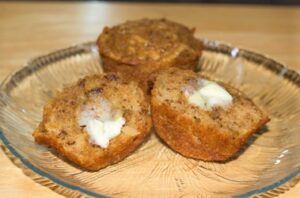 Great breakfasts around here this week! Remember the principle that you frontload your day, eating a hearty breakfast and then a lighter lunch and an even lighter dinner, with no evening snacking. This morning I threw together a rather complicated crustless quiche that used up most of a container of spinach that I had foolishly bought last week and the rest of an opened log of goat cheese. I will point out that soft goat cheese is richer and tangier than regular cream cheese—as well as being more expensive, of course. But I buy mine at Costco, and although it comes in a two-pack I think the unopened log will stay good for a while. So I found a recipe this morning for “Quick and Easy Spinach Quiche,” using fresh spinach instead of frozen (because that was what I had) and goat cheese for the cream cheese (ditto). And I didn’t have a pastry shell sitting around, all rolled out and ready to go, so that wasn’t in the mix. I just sprayed the pie pan with Pam and sprinkled panko breadcrumbs into it, sautéed the onions until browned and then added the chopped-up spinach and cooked until it wilted, let that cool while I crumbled up the goat cheese into the pie pan, mixed up the milk and eggs, and grated the cheese (which happened to be Gouda but could be cheddar or any other flavorful grating cheese). Everything went into the pan and it baked for about 45 minutes at 3250. I realize that not everyone has that kind of time in the mornings, but I like to get up early and can put together somewhat elaborate breakfasts. Jim and I ate about half of it.
Great breakfasts around here this week! Remember the principle that you frontload your day, eating a hearty breakfast and then a lighter lunch and an even lighter dinner, with no evening snacking. This morning I threw together a rather complicated crustless quiche that used up most of a container of spinach that I had foolishly bought last week and the rest of an opened log of goat cheese. I will point out that soft goat cheese is richer and tangier than regular cream cheese—as well as being more expensive, of course. But I buy mine at Costco, and although it comes in a two-pack I think the unopened log will stay good for a while. So I found a recipe this morning for “Quick and Easy Spinach Quiche,” using fresh spinach instead of frozen (because that was what I had) and goat cheese for the cream cheese (ditto). And I didn’t have a pastry shell sitting around, all rolled out and ready to go, so that wasn’t in the mix. I just sprayed the pie pan with Pam and sprinkled panko breadcrumbs into it, sautéed the onions until browned and then added the chopped-up spinach and cooked until it wilted, let that cool while I crumbled up the goat cheese into the pie pan, mixed up the milk and eggs, and grated the cheese (which happened to be Gouda but could be cheddar or any other flavorful grating cheese). Everything went into the pan and it baked for about 45 minutes at 3250. I realize that not everyone has that kind of time in the mornings, but I like to get up early and can put together somewhat elaborate breakfasts. Jim and I ate about half of it.
healthy eating
Why All Fad Diets “Work,” at Least Temporarily
 My husband listens to a podcast called “The Art of Manliness,” but it should really be called “The Art of Living Well.” They’re up to well over 500 episodes, with different guests and topics. A recent one featured Dr. Dr. John Berardi, who earned a PhD in exercise physiology and nutrient biochemistry, and is a writer, athlete, coach, and professor, as well as the co-founder of Precision Nutrition and the founder of the Change Maker Academy. So this is a guy who actually has scientific chops. He’s not peddling some nutty theory and trying to make money off of it. I found this podcast episode to be so packed with good information that I had to listen to it in chunks, then stop and absorb what I’d heard before going on to the next section.
My husband listens to a podcast called “The Art of Manliness,” but it should really be called “The Art of Living Well.” They’re up to well over 500 episodes, with different guests and topics. A recent one featured Dr. Dr. John Berardi, who earned a PhD in exercise physiology and nutrient biochemistry, and is a writer, athlete, coach, and professor, as well as the co-founder of Precision Nutrition and the founder of the Change Maker Academy. So this is a guy who actually has scientific chops. He’s not peddling some nutty theory and trying to make money off of it. I found this podcast episode to be so packed with good information that I had to listen to it in chunks, then stop and absorb what I’d heard before going on to the next section.
Join Me in No-Sugar November
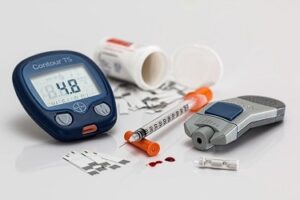 Well, this past Friday, Nov. 1, was supposed to be an encouraging day because I had scheduled an A1C re-test, using the second kit in the two-pack that my in-laws gave me for my birthday back in March. (As I’ve said before, the A1C test measures what percentage of your hemoglobin cells have glucose molecules stuck to them, and since those cells live for only three months your results are seen as a three-month view of your blood sugar rather than the one-time reading you get from a simple glucose monitor.) That March test had registered as a 5.3, which was super, super great–but I wasn’t completely sure that it was accurate. Although the brand I had (from Walgreen’s) is pretty well rated, I just didn’t think I could possibly have a score that low. There’s been one time that I hit 5.7, which is the threshold for what is called “pre-diabetes,” the yellow warning zone that comes before the red alert of 6.5 of higher. Once you hit 6.5 you’re considered to have full-blown diabetes. I’ve usually hovered in that 6.0-6.4 range, and as far as I know I’ve never hit 6.5 My doctor told me at one point that he didn’t think I would ever topple over into full-blown diabetes, and I sure hope he’s right.
Well, this past Friday, Nov. 1, was supposed to be an encouraging day because I had scheduled an A1C re-test, using the second kit in the two-pack that my in-laws gave me for my birthday back in March. (As I’ve said before, the A1C test measures what percentage of your hemoglobin cells have glucose molecules stuck to them, and since those cells live for only three months your results are seen as a three-month view of your blood sugar rather than the one-time reading you get from a simple glucose monitor.) That March test had registered as a 5.3, which was super, super great–but I wasn’t completely sure that it was accurate. Although the brand I had (from Walgreen’s) is pretty well rated, I just didn’t think I could possibly have a score that low. There’s been one time that I hit 5.7, which is the threshold for what is called “pre-diabetes,” the yellow warning zone that comes before the red alert of 6.5 of higher. Once you hit 6.5 you’re considered to have full-blown diabetes. I’ve usually hovered in that 6.0-6.4 range, and as far as I know I’ve never hit 6.5 My doctor told me at one point that he didn’t think I would ever topple over into full-blown diabetes, and I sure hope he’s right.
Happy Halloween! (And How to Stay Away from the Candy)
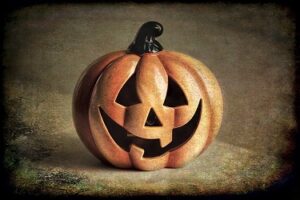 I have a podcast on my “favorites” list from Dr. Al Mohler, president of Southern Seminary, the flagship divinity school for the Southern Baptist Convention. I’ve heard him preach a number of times at our former church, Capitol Hill Baptist, which we attended from 1999 to our move here in 2009. He’s a great guy for whom I have great respect and is very much concerned about the direction our society is going, but sometimes this concern causes him to overreact a little. So back when the whole drag-queen story-hour brouhaha broke out (and if you missed out on that one, lucky you! I’m a committed David Frenchian on the subject), Dr. Mohler saw it as a “cultural crisis.” We all needed to Do Something About It. But the thing of it was, and is, that these events are local and non-compulsory. Giving so much attention to them vaulted the performers into the spotlight for weeks.
I have a podcast on my “favorites” list from Dr. Al Mohler, president of Southern Seminary, the flagship divinity school for the Southern Baptist Convention. I’ve heard him preach a number of times at our former church, Capitol Hill Baptist, which we attended from 1999 to our move here in 2009. He’s a great guy for whom I have great respect and is very much concerned about the direction our society is going, but sometimes this concern causes him to overreact a little. So back when the whole drag-queen story-hour brouhaha broke out (and if you missed out on that one, lucky you! I’m a committed David Frenchian on the subject), Dr. Mohler saw it as a “cultural crisis.” We all needed to Do Something About It. But the thing of it was, and is, that these events are local and non-compulsory. Giving so much attention to them vaulted the performers into the spotlight for weeks.
A Shocking Statistic, and Holding onto Accidental Weight Loss
 This morning on the “Happier” podcast Gretchen Rubin gave a truly shocking statistic:
This morning on the “Happier” podcast Gretchen Rubin gave a truly shocking statistic:
“Research suggests that Americans consume an astonishing 30% of their daily calories in the evening, after 8:00 p.m., and as the day wears on, we tend to choose increasingly unhealthy options.” (from the show notes for the 10/23/19 episode)
There’s some controversy about whether or not this evening snacking causes actual weight gain in and of itself; in other words, are calories consumed in the evening more likely to be stored as fat than those consumed during the day? According to Healthline, which I’ve found to be a pretty good online resource: “You won’t gain weight by merely eating later if you eat within your daily calorie needs. Still, studies show that nighttime eaters typically make poorer food choices and eat more calories, which can lead to weight gain.” As Gretch and Liz say in the podcast, you aren’t going to be eating celery sticks or scrambled eggs at 10:00 PM; you’ll be eating junk/snack/convenience food. (Liz mentions Cheez-Its.) Of course, one way to keep yourself from eating junk food at 10:00 PM is to not have the junk food in the house.
Take a Sip Instead of a Snack
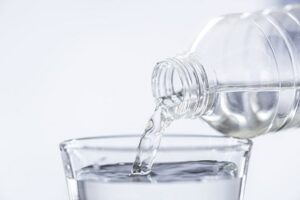
Hi folks! I’m rather taken aback to see that it’s been over a month since I posted anything on this blog. Are you a subscriber? If not, sign up on the sidebar. How about to my other blog, Behind the Music? You can also sign up for that one on the same form, or you can follow the link and see what’s going on there first. That blog seems to be consuming a lot of my time and attention these days, but I’m still very interested in writing about food and health, so I want to make a stab at keeping both sites going.
The Daniel Diet, Part 3–What Does the Bible Actually Say?
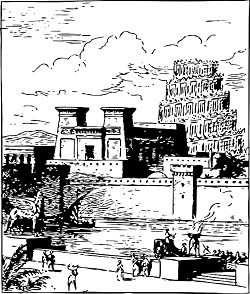
The whole idea of the Old Testament prophet’s being a health and wellness guru was given a bit of juice in January of this year when the superstar actor Chris Pratt announced on Instagram that he was going on a 21-day “Daniel Fast” (which is only slightly different from the original 40-day Daniel Diet Plan). Today I want to take a look at the initial Scripture passage that has given rise to this whole craze. First, though, some historical background:
Although some Bible scholars want to give the writing of this prophetic book a later date, according to the actual events described it dates to sometime around 600 BC and takes place beginning with Nebuchadnezzar’s successful siege of Jerusalem in which he captures the city, burning much of it down, and carries off both inhabitants and sacred vessels from Solomon’s temple, which he destroys. During the siege the inhabitants of Jerusalem run out of food, and then perhaps ten thousand of them are taken into exile by being marched off to Susa, the capital of Babylon, a distance of almost 850 miles. So believe me when I say that Daniel and his friends had no need of a weight-loss diet! They were probably skin and bones by the time they finally arrived in Babylon. (There are actually multiple sieges of Jerusalem by the Babylonian army, but I’m not getting into all those details here.)
Yet Another Fad Diet—This One with a Biblical Slant
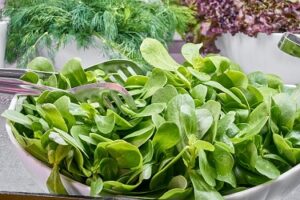
It’s been over a week since I’ve posted anything on this blog, but that lack of posting doesn’t mean that I haven’t been thinking and pondering about various food fads floating around in our modern society. As I said in my previous short post about the blood-type diet, I had thought that I’d pretty well covered at least the most egregious fads out there, but there’s always something more to be explored in this area.
How to Make Your Own Pie for the Fourth of July (Or Any Other Holiday)
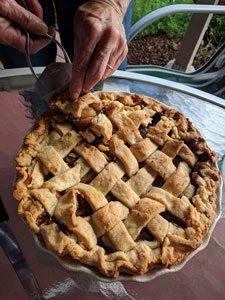 I’ve decided that I will be making two pies a year from now on, the Brandied Butternut Squash Pie from the peerless Melissa Clark that I made for Thanksgiving last year and this apple pie for July 4th. (I don’t think pies count as “massive.”) While I’ve made apple pies in the past, and I liked them okay, there were problems:
I’ve decided that I will be making two pies a year from now on, the Brandied Butternut Squash Pie from the peerless Melissa Clark that I made for Thanksgiving last year and this apple pie for July 4th. (I don’t think pies count as “massive.”) While I’ve made apple pies in the past, and I liked them okay, there were problems:
1. The apples always seemed to be partly raw.
2. The crust tended to be soggy on the bottom.
But in spite of these drawbacks I wanted to make an apple pie sometime during the July 4th weekend. This desire was mainly fired by a Sally’s Baking Addiction post in which she demonstrated how
A Beautiful Loaf of Bread
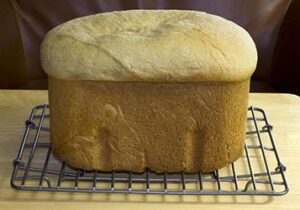 As I’ve been working on the chapter on bread in my planned forthcoming cookbook (when it will come forth is very much an open question), I got inspired to make a bread-machine loaf, something I don’t usually do. My breadmaking usually falls into much more controllable territory–rolls, pizza dough, breadsticks, and overnight bread baked as a round. I don’t have to worry about whether or not rolls are going to cave in, as they are baked outside of the machine. I can eyeball how far they’ve risen and adjust accordingly. But a big loaf is inherently much more unstable, and you can’t tweak the machine’s cycle after it has started. Here it is, though. I was reminded of a passage from Louisa May Alcott’s Eight Cousins, in which the orphan Rose is raised by her Uncle Alec. She takes housekeeping lessons from one of her aunts as a part of her education, and here’s how her baking lessons come out:
As I’ve been working on the chapter on bread in my planned forthcoming cookbook (when it will come forth is very much an open question), I got inspired to make a bread-machine loaf, something I don’t usually do. My breadmaking usually falls into much more controllable territory–rolls, pizza dough, breadsticks, and overnight bread baked as a round. I don’t have to worry about whether or not rolls are going to cave in, as they are baked outside of the machine. I can eyeball how far they’ve risen and adjust accordingly. But a big loaf is inherently much more unstable, and you can’t tweak the machine’s cycle after it has started. Here it is, though. I was reminded of a passage from Louisa May Alcott’s Eight Cousins, in which the orphan Rose is raised by her Uncle Alec. She takes housekeeping lessons from one of her aunts as a part of her education, and here’s how her baking lessons come out: